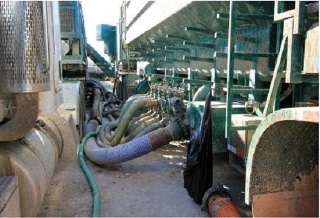Nov 21 2017
The demand for energy in society depends mainly on gas and oil, which are finite resources. Future technologies could help reduce energy consumption, but until then, current resources should be managed carefully.
Director of the Ali I. Al-Naimi Petroleum Engineering Research Center at KAUST Tadeusz Patzek is applying physics to tackle this challenge by modeling the gas production from fracking.
 To generate sand slurry requires a low-pressure manifold to mix water and polymers with sand. © 2017 Tadeusz Patzek
To generate sand slurry requires a low-pressure manifold to mix water and polymers with sand. © 2017 Tadeusz Patzek
Patzek and his collaborators describe two opinions of global energy consumption. Optimists believe that human population, economies and energy use can keep on growing exponentially because humans will continue to invent innovative ways to survive. However, others note that the Earth forces clear limitations on growth, meaning that the production of energy will peak before tailing off.
Gas and oil production has certainly reached peaks in the past, but these have been assumed by discoveries of new technologies and reserves for extracting fuels from previously inaccessible regions. Fracking (hydraulic fracturing) of ancient ocean beds known as shale formations is the most controversial and complex new process. Fracking requires injecting water and sand into shale layers at high pressure several kilometers underground, generating cracks that release trapped hydrocarbons.
My coauthors, Scott Tinker and Michael Marder, and I, worked on a Sloan Foundation project, whose goal was to model gas recovery from shales in the US in unprecedented detail.
Tadeusz Patzek, Ali I. Al-Naimi Petroleum Engineering Research Center, KAUST
Instead of using current gas-well simulations, which are time-consuming and complex to run, the researchers were inspired by the simple, well-designed models of condensed-matter physics, such as those controlling electron transport at low temperatures.
The ensuing model needs very few parameters in order to model the diffusion of gas out of fracking wells, and the researchers confirmed it by accurately predicting the output of 14000 gas wells in the US.
In general, the study revealed that only 10 to 20% of natural gas in fracking fields is being extracted using the existing techniques. This suggests that, although technical enhancements could extend the lifetime of fracking as a beneficial fuel source, the flood of gas predicted by a number of industrialists is not yet guaranteed.
Patzek won’t state whether he is a pessimist or an optimist concerning fracking. “I am neither,” he says.
I am a scientist, and my outlook on nature is governed strictly by the chemistry and physics of the processes at hand. However, I am also an avid environmentalist, and from this perspective, business as usual is ending for humanity.
Tadeusz Patzek
Patzek and his collaborators have certainly revealed that physicists have a role to play in developing innovative business models for future energy sources.